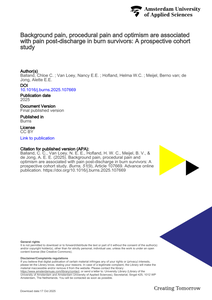Pain following burn injuries can be severe and may persist after hospital discharge. The experience of pain is influenced by multiple biological and psychosocial factors. Post-discharge pain may be related to pain experienced during hospitalization as well as anxiety associated with these pain experiences. There are also protective factors; one notable example is optimism. However, the role of optimism in burn-related pain has not yet been investigated. This study aimed to describe the extent of pain measured over 14 consecutive days post-discharge and to examine its relationship with background pain, procedural pain, pain-related anxiety, and optimism. This multi-center longitudinal cohort study was conducted in five burns centres. The results showed that 50 % of the patients had a pain score ≥ 2 on a 0 – 10 scale after discharge, which on average decreased further over the next 14 days. However, a subgroup of patients maintained elevated pain levels. Patients with higher pain scores post-discharge were more likely to have experienced higher levels of background pain and procedural pain in-hospital and they scored lower on optimism. Pain-related anxiety did not independently contribute to pain post-discharge. The results indicate that patients with high pain scores during hospital admission may need specific attention regarding pain management when they leave the hospital. Furthermore, patients may benefit from optimism-inducing interventions in the hospital and thereafter.
DOCUMENT

Objective To develop and internally validate a prognostic model to predict chronic pain after a new episode of acute or subacute non-specific idiopathic, non-traumatic neck pain in patients presenting to physiotherapy primary care, emphasising modifiable biomedical, psychological and social factors. Design A prospective cohort study with a 6-month follow-up between January 2020 and March 2023. Setting 30 physiotherapy primary care practices. Participants Patients with a new presentation of non-specific idiopathic, non-traumatic neck pain, with a duration lasting no longer than 12 weeks from onset. Baseline measures Candidate prognostic variables collected from participants included age and sex, neck pain symptoms, work-related factors, general factors, psychological and behavioural factors and the remaining factors: therapeutic relation and healthcare provider attitude. Outcome measures Pain intensity at 6 weeks, 3 months and 6 months on a Numeric Pain Rating Scale (NPRS) after inclusion. An NPRS score of ≥3 at each time point was used to define chronic neck pain. Results 62 (10%) of the 603 participants developed chronic neck pain. The prognostic factors in the final model were sex, pain intensity, reported pain in different body regions, headache since and before the neck pain, posture during work, employment status, illness beliefs about pain identity and recovery, treatment beliefs, distress and self-efficacy. The model demonstrated an optimism-corrected area under the curve of 0.83 and a corrected R2 of 0.24. Calibration was deemed acceptable to good, as indicated by the calibration curve. The Hosmer–Lemeshow test yielded a p-value of 0.7167, indicating a good model fit. Conclusion This model has the potential to obtain a valid prognosis for developing chronic pain after a new episode of acute and subacute non-specific idiopathic, non-traumatic neck pain. It includes mostly potentially modifiable factors for physiotherapy practice. External validation of this model is recommended.
LINK
Introduction: Illness Perceptions (IPs) may play a role in the management of persistent low back pain. The mediation and/or moderation effect of IPs on primary outcomes in physiotherapy treatment is unknown. Methods: A multiple single-case experimental design, using a matched care physiotherapy intervention, with three phases (phases A-B-A’) was used including a 3 month follow up (phase A’). Primary outcomes: pain intensity, physical functioning and pain interference in daily life. Analyzes: linear mixed models, adjusted for fear of movement, catastrophizing, avoidance, sombreness and sleep. Results: Nine patients were included by six different primary care physiotherapists. Repeated measures on 196 data points showed that IPs Consequences, Personal control, Identity, Concern and Emotional response had a mediation effect on all three primary outcomes. The IP Personal control acted as a moderator for all primary outcomes, with clinically relevant improvements at 3 month follow up. Conclusion: Our study might indicate that some IPs have a mediating or a moderating effect on the outcome of a matched care physiotherapy treatment. Assessing Personal control at baseline, as a relevant moderator for the outcome prognosis of successful physiotherapy management of persistent low back pain, should be further eplored.
DOCUMENT
